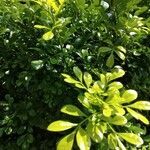A small tree. It grows 5-8 m tall. The leaves have leaflets along the stalk. There are 3-7 leaflets opposite each other and these are 1-7 cm long by 1-4 cm wide. The flowers are golden yellow. They grow in clusters along the branches. They droop and have a scent. They smell like cymbidiums and look like rice grains which gives it its Chinese name. Trees are separately male and female.
Bush or sometimes tree to 10 m. Indumentum of yellowish-brown stellate scales, especially dense on shoot apex and fruit surface. Leaves imparipinnate, 1-or 2-(or 3-) jugate, rachis sometimes narrowly winged. Inflorescence with widely spaced, yellow, fragrant flowers. Fruits obovoid, c. 1 by 0.7 cm, red, brown or orange.
Shrub or small tree up to 10 m. tall.. Leaflets 3–5, glabrous, venation reticulate on both surfaces.. Flowers very small, in axillary panicles, strongly scented, used (elsewhere) for flavouring tea and perfuming clothes.. Fruit a small cleistocarp.


